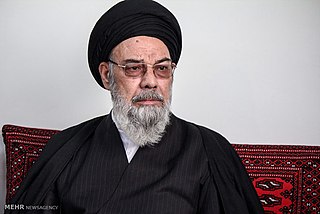
Persian Wikipedia is the Persian language version of Wikipedia. The Persian version of Wikipedia was started in December 2003. As of May 2024, it has 1,002,501 articles, 1,311,412 registered users, and 90,623 files, and it is the 19th largest edition of Wikipedia by article count, and ranks 22nd in terms of depth among Wikipedias. It passed 1,000 articles on December 16, 2004, and 200,000 on July 10, 2012. Roozbeh Pournader is the project's first administrator, developer, and bureaucrat.
Iran is known for having one of the world's most comprehensive Internet censorship systems. The Iranian government and the Islamic Revolutionary Guard Corps (IRGC) have blocked access to many popular websites and online services, including YouTube, Twitter, Facebook and Telegram. Internet traffic in the country is heavily restricted and monitored.

The Ministry of Sport and Youth is the government ministry of youth affairs and sports in the Islamic Republic of Iran. It was founded in 2010 after the Physical Education Organization was dissolved.
Mahdi is computer malware that was initially discovered in February 2012 and was reported in July of that year. According to Kaspersky Lab and Seculert, the software has been used for targeted cyber espionage since December 2011, infecting at least 800 computers in Iran and other Middle Eastern countries. Mahdi is named after files used in the malware and refers to the Muslim figure.

(Seyyed) Yousef Tabatabai Nejad is an Iranian Shia cleric and Friday leading prayer that represents the Isfahan Province in Iran's Assembly of Experts.
The 2018 Iranian university protests were a series of protests, a spillover clash of the 2017–2018 Iranian protests, occurring as part of the wider Iranian Democracy Movement, by Iranian university students in support of labour, and teacher strikes, as well as protesting against the current situation of the country. The protests started on 4 December 2018, ahead of university day on 7 December, which is usually marked by protests.
The Mahshahr massacre refers to the mass killing of protesters in the city of Mahshahr, Iran, which occurred between 16 November and 20 November 2019, during the 2019–2020 Iranian protests. Estimates of fatalities range between 40 and 150.
The 2021 Sistan and Baluchestan protests were a series of protests in the Sistan and Baluchestan province of Iran. The protests started on 23 February 2021 after multiple Baloch fuel traders were killed at the Iran–Pakistan border.
Babak Khorramdin was an Iranian director and writer.
The Iranian fuel 2021 cyberstrike was an attack on the Iranian fuel system, government-issued cards used for buying subsidized fuel, and digital road billboards. The attack took place on 26 October 2021. The government announced that people had to buy gas without their ration card. According to the Supreme Council of Cyberspace, the attacks were similar to the attack on the Iranian rail road transit system in July. Iranian President Ebrahim Raisi stated, "this cyberattack is neither the first time nor will it be the last."

Islamic Revolutionary Guard Corps Research and Self-Sufficiency Jihad Organization is a R&D unit institution established in 1993. According to IRGC, it was attacked in 2021. It has buildings based in Isfahan and Tehran.

Correspondence between Barack Obama and Ali Khamenei started with direct and confidential letters sent by US President Barack Obama to Iranian leader Ali Khamenei aimed at persuading him to negotiate. Ali Shamkhani, Representative of the Supreme Leader and Secretary of the Supreme National Security Council of Iran, confirmed that his country had responded to some of Barack Obama's letters to the Iranian leader, which focused mainly on the issue of Iran's nuclear program. This was the first time that Iran had confirmed such correspondence with the President of the United States. Earlier, domestic and foreign media reported on Barack Obama's letters to Khamenei, which in one case were confirmed by Hassan Firouzabadi, Chief-of-Staff of the Iranian Armed Forces, as a sign of the US government's realism.
The Zahedan massacre, also known as Bloody Friday (Balochi: زائدانءِ ھۏنݔن آدݔنَگ), was a series of violent crackdowns starting with protesters gathering and chanting in front of a police station near the Great Mosalla of Zahedan, Iran on 30 September 2022 leading to many casualties.
This list reports the notable citizens, civil and political activists, students, journalists, lawyers and athletes who have been arrested in Iran during the ongoing protests sparked by the death of Mahsa Amini in September 2022. There is no clear information about the whereabouts and the situation of many of them.
Death sentences during the Mahsa Amini protests is a list of Iranian citizens sentenced to death or charged with crimes punishable by death in the Islamic Republic of Iran during the Mahsa Amini protests. Following rushed trials that were widely criticized by human rights organizations, the Islamic Republic has executed seven protestors, Mohsen Shekari, Majidreza Rahnavard, Mohammad Mehdi Karami, Seyyed Mohammad Hosseini, Saleh Mirhashemi, Majid Kazemi, and Saeed Yaghoobi. Dozens of protesters have been charged with offenses that are punishable by death in Iran.
Hamid Ghareh-Hassanlou was arrested in nationwide protests in Iran after the death of Mahsa Amini. He is a Gonabadi dervish and a medical doctor who specializes in medical imaging. He was charged with killing a Basiji member during the funerals of Hadis Najafi by the Islamic Revolutionary Court in Karaj. His wife, Farzaneh Ghareh-Hassanlou was arrested the same day. They were reportedly beaten during the arrest, and Hamid's ribs were later reported broken.
Sahand Noormohammadzadeh is a bodybuilder and one of the prisoners of 2022-2023 Iranian protests in Tehran, who was sentenced to death for destroying and setting fire to public facilities. On November 16, he was tried for the charge of "waging war against God and the state" in Branch 29 of the Revolutionary Court of Tehran.
The Islamic Revolutionary Guards Corps Cyber Security Command is a command of the Iranian Islamic Revolutionary Guard Corps responsible for cyber warfare and cyber security. It was founded in 2006(1386), its command was established in 2015(1393).
The Amirkabir Newsletter is a student media outlet that began its activities at Amirkabir University of Technology in the late 1990s. Currently, this outlet is active on social networks such as Telegram, Instagram, and Twitter.
 November 2018: The Iranian telecommunication minister Mohammad-Javad Azari Jahromi accuses Israel of a failed cyberattack on its telecommunications infrastructure, and vows to respond with legal action. [14] [15]
November 2018: The Iranian telecommunication minister Mohammad-Javad Azari Jahromi accuses Israel of a failed cyberattack on its telecommunications infrastructure, and vows to respond with legal action. [14] [15] 



